Comparison Shopping
COMPARISON SHOPPING
by Noel Wood
There’s always another choice. At least lately. There have been several instances as of late where two films have hit around the same time that both deal with a similair subject. Here I will compare and contrast these films, and tell you which one you’d be wiser to invest your hard-earned dollar in seeing.
1. THE THIN RED LINE (Terence Malick, 1998) vs. SAVING PRIVATE RYAN (Steven Spielberg, 1998)
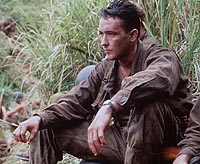
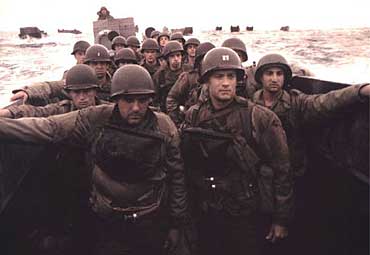
So both were up for the Best Picture Oscar for 1998. Both feature A-list ensemble casts. And both deal with World War II. Now, granted, they take place in two different theaters of that war, so in fact they’re vastly different, but since it’s the same war, they’re close enough. Both also lean toward the three-hour mark.
Cast:
TRL: Nick Nolte, Sean Penn, John Cusack, Woody Harrelson, John Travolta, Elais Koteas, Ben Chaplin, George Clooney, Adrien Brody, Jared Leto, John C. Reilly.
SPR: Tom Hanks, Tom Sizemore, Adam Goldberg, Edward Burns, Giovanni Ribisi, Jeremy Davies, Matt Damon, Ted Danson, Paul Giamatti, Dennis Farina.
Overview: While THE THIN RED LINE boasts a larger, more viewer-friendly cast, many of the stars are peppered in cameo roles and are hardly seen. SAVING PRIVATE RYAN uses younger actors who are hardly household names but gives them more of a chance to perform.
Advantage: SAVING PRIVATE RYAN
Story:
TRL: Nick Nolte is a stern Colonel who leads an invasion on Guadalcanal in the Pacific Theater of the war. He encounters a rebellious Captain (Koteas) who disagrees with his battle plans. Thanks to the help of some enthusuastic privates, the team takes control of a Japanese bunker on the island.
SPR: Tom Hanks leads a group of soldiers in France to find the last surviving brother in the Ryan clan and give him his discharge. Once they find Ryan, they must stage a defensive in a French town to deflect a German invasion.
Overview: THE THIN RED LINE gives a raw, dirty look at war from the ground. The emotion is sacrificed for a more gritty depiction of battle. SAVING PRIVATE RYAN also has its share of rough battle scenes, but the story is a more emotional one of sacrifice and determination.
Advantage: SAVING PRIVATE RYAN
Characters:
Overview: THE THIN RED LINE employs more believable, rougher wartime characters than its counterpart, although some of them get lost in the shuffle. I was still trying to figure out who the star of the film was by the end. It started off as Brody’s vehicle, then moved on to Penn and Nolte, then Koteas, then finally back to Brody. SAVING PRIVATE RYAN had a few great characters but was indeed flawed and stereotyped. Hanks, Sizemore, Burns, and Ribisi’s characters were brilliantly written but Goldberg, Davies, and especially Damon’s parts left a lot ot be desired.
Advantage: THE THIN RED LINE
Technical:
TRL: Wonderful cinematography in the battle scenes, shot from the grass. Powerful score. Fantastically deliberate camerawork throughout.
SPR: UNBELIEVABLE battle scenes with PERFECT special effects. Great score. Unmemorable camerawork later in the film, but the opening sequence almost makes up for it.
Advantage: THE THIN RED LINE
Flow/Script:
TRL: Choppy, disjointed. Felt like 8 hours of footage had been trimmed down and squeezed in to a three hour block. Not coincedentally, this was the case. Vague ending left a lot to be desired. This movie FELT like 3 hours.
SPR: Good overall pacing, with very few slow periods. Later scenes with Damon start to feel forced at times, but an exciting and emotional battle scene at the end justifies it. Very entertaining, much like TITANIC, the three hours went by fast.
Advantage: SAVING PRIVATE RYAN.
Conclusion:So Ryan takes this one 3-2. But I dare not discourage anyone from seeing both films, as they are both breathtaking depictions of battle.
2. ANTZ (Eric Darnell/Lawrence Gutterman, 1998) vs. A BUG’S LIFE (John Lasseter/Andrew Stanton, 1998)
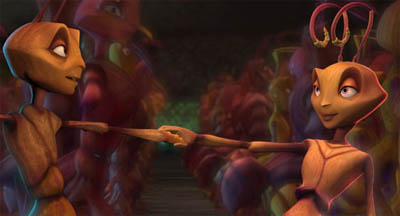
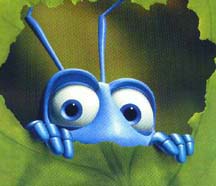
Two animated films employing the use of CGI. Both movies happen to be about ant colonies. And both feature ensemble casts of A-list actors. A BUG’S LIFE was Disney and Pixar’s project, but former Disney exec Jeff Katzenberg decided to beat Disney to the punch by releasing ANTZ under the fledgeling film company Dreamworks SKG. Coincidentally, this is the second time that Steven Spielberg is behind one of the two products being compared.
Cast:
ANTZ: Woody Allen, Sharon Stone, Sylvester Stallone, Jennifer Lopez, Anne Bancroft, Gene Hackman, Christopher Walken, Danny Glover, John Mahoney, Dan Aykroyd, Jane Curtin.
LIFE: David Foley, Julia Louis-Dreyfus, Kevin Spacey, Phyllis Diller, Denis Leary, David Hyde Peirce, Madeline Kahn, John Ratzenberger, Bonnie Hunt, Roddy McDowall.
Overview: ANTZ has bigger name stars and uses them to perfection. Allen, Stallone, Stone, and Walken particularly do a great job in incorporating their past work in with this film. A BUG’S LIFE is bolder in its use of an unproven star (Foley) as its lead, but backs it up brilliantly with the incredible performances of Spacey, Leary, and Louis-Dreyfus.
Advantage: ANTZ.
Story:
ANTZ: Neurotic worker ant Z (Allen) falls for the colony’s princess (Stone) and decided to see what life is like on the other side. After escaping the colony, he and the princess must overcome the general’s plans to flood its inhabitants and save the ants.
LIFE: Resourceful worker ant Flik (Foley) is disgraced after his clumsiness causes a food shortage, angering the grasshoppers who bully the colony. Shunned, he finds a group of roving circus insects and hires them to battle the grasshoppers and save the colony.
Overview: ANTZ has a clever storyline which avoids generic youth movie stereotypes and conveys a very serious message of individuality. A BUG’S LIFE has a generic Disney feel to it, but nonetheless is an entertaining and funny story.
Advantage: ANTZ.
Characters:
Overview: ANTZ does well to create characters out of the ants alone, often incorporating the likeness of the actor in the role in to the character. Unfortunately, not much is done to elaborate on that many characters outside of the lead, including the villain (Hackman). A BUG’S LIFE not only creates likeable characters out of the ants, but also gets some of the best work out of the circus performers. The nemesis in the story (Spacey) is fearsome and brash.
Advantage: A BUG’S LIFE.
Technical:
Overview: ANTZ looks good, but the facial characteristics of the animated characters are a bit eerie for children. The overall tone is dark, which once again may be detrimental for the youth viewing audience. A good dramatic score and great song choices help things a bit. A BUG’S LIFE is colorful and vibrant, and the CGI is rendered brilliantly by Pixar, arguably the best CG company on the planet. Unfortunately the Randy Newman score leaves a lot to be desired.
Advantage: A BUG’S LIFE
Script/Flow:
ANTZ: Once again, a nice change of pace from the usual formulaic Disney junk. Excellent bits of humor and movie parody which are well above the level of the movie’s target audience. Fun and fast-paced.
A BUG’S LIFE: Formulaic and methodical, but fun nonetheless. Great characters and fun dialogue make this an enjoyable film for all ages.
Advantage: A BUG’S LIFE.
Conclusion: A BUG’S LIFE takes this one 3-2, but that doesn’t mean ANTZ isn’t worth seeing. As a matter of fact, I would suggest ANTZ over A BUG’S LIFE for adults, considering its more mature bits of humor and darker tone. But considering these films should be able to be enjoyed by both children AND adults, I give the nod to the one that delivers the better all-around product.
3. THE TRUMAN SHOW (Peter Weir, 1998) vs. EDTV (Ron Howard, 1999)
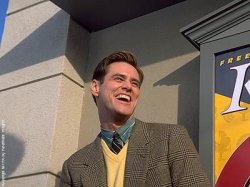
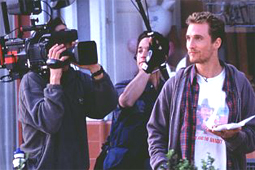
Two films released in two different years, but both deal with the subject of having one’s life broadcast 24 hours a day on television. Weir’s THE TRUMAN SHOW stars Jim Carrey as a man whose whole life has been formulated on a sound stage without his knowledge. Howard’s EDTV involves a man who volunteers to be broadcast. Many people compared THE TRUMAN SHOW and 1998’s PLEASANTVILLE, which involves two teenage siblings who are transported in to a 1950’s sitcom, but I felt that these two films shared more similairity.
Cast:
TRUMAN: Jim Carrey, Laura Linney, Ed Harris, Paul Giamatti, Phillip Baker Hall, Natascha McElhone.
EDTV: Matthew McConaughey, Woody Harrelson, Jenna Elfman, Rob Reiner, Ellen DeGeneres, Sally Kirkland. Martin Landau, Dennis Hopper, Elizabeth Hurley, Adam Goldberg, Clint Howard.
Overview: THE TRUMAN SHOW makes grand use of two main players: Carrey as Truman, and Harris as Christof. The rest of the cast is forgettable, but the two main performances are brilliant. EDTV overcomes a weak lead (McConaughey, Harrelson, Elfman) with a strong supporting cast.
Advantage: EDTV.
Story:
TRUMAN: Truman Burbank is born on TV, raised on TV, and lives on TV, unbeknownst to him. As unusual occurences begin happening, he evaluates his life and realizes what is happening, much to the dismay of Christof, the show’s creator.
EDTV: Perennial slacker video clerk Ed Pekurny volunteers to be broadcast 24 hours a day. As important life events are affected by the cameras’ influence, he wishes to pull the plug on the TV operation, much to the dismay of Whitaker, the show’s producer.
Overview: THE TRUMAN SHOW is more surreal, more original, and more emotional. Even in the over-the-top comedic stunts, the movie gives a real feeling of entrapment and enclosure. EDTV is formulaic comedy with plenty of weak spots and a far less powerful emotional aspect.
Advantage: THE TRUMAN SHOW.
Characters:
Overview: THE TRUMAN SHOW centers around Carrey and Harris almost exclusively, and it works. This paralells the tone of the film’s scenario. The supporting players are hardly touched upon, and in this case, that’s a good thing. EDTV tries to be an ensemble, which is a good thing considering the weakness of the leads, but the characters all wind up seeming to be trite stereotypes in the process. I found Landau’s invalid stepfather to be the most intiguing character, and that’s not necessarily a good thing.
Advantage: THE TRUMAN SHOW.
Technical:
Overview: THE TRUMAN SHOW is beautifully shot. Rich, bright, colorful sets and awkward camera angles give a real claustrophobic feeling to the film. A bouncy, uplifting score also adds to the tone. EDTV is conventional with forgettable cinematography and score.
Advantage: THE TRUMAN SHOW.
Script/Flow:
TRUMAN: My only complaint is the flip-flopping from documentary to narrative formats in the film. Aside from that, the script itself was fine, with very funny moments and a tolerable pacing that made the film go by quickly.
EDTV: Fine pacing with a decent enough script, but too many failed bits of humor and emotion to count. Predictable moments in the film culminating with an ending that was funny but hardly worth the setup.
Advantage: THE TRUMAN SHOW.
Conclusion: Not even close here. THE TRUMAN SHOW tops EDTV 4-1.

 subscribe to rss
subscribe to rss 

























sitemap
sitemap
Leave your response!